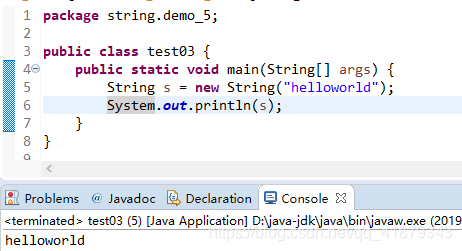java中String类的常用功能以及方法
本文共 4590 字,大约阅读时间需要 15 分钟。
java中String类的常用功能以及方法
一. 构造方法:
1. String(String original);
功能:把字符串数据封装成字符串对象;
示例:package string.demo_5;public class test03 { public static void main(String[] args) { String s = new String("helloworld"); System.out.println(s); }} 
2. String(char[] value);
功能:把字符数组的数据封装成字符串对象
示例:package string.demo_5;public class test03 { public static void main(String[] args) { char[] str = {'h','e','l','l','o'}; String s = new String(str); System.out.println(s); }} 
3. String(char[] value, int index, int count);
功能:把字符数组中的一部分数据封装成字符串对象,即:将字符数组中以索引为index开头以及后面的数据,共count个数据封装成字符串对象;
示例:package string.demo_5;public class test03 { public static void main(String[] args) { char[] str = {'h','e','l','l','o'}; String s = new String(str,1,3); System.out.println(s); }} 
二. String类的判断功能:
1. boolean equals(Object obj);
功能:比较字符串的内容是否相同;
示例:package string.demo_5;public class test03 { public static void main(String[] args) { String s1 = "hello"; String s2 = "hello"; String s3 = "Hello"; System.out.println(s1.equals(s2)); System.out.println(s1.equals(s3)); }} 
2. boolean equalsIgnoreCase(String str);
功能:比较字符串的内容是否相同,忽略大小写;
示例:package string.demo_5;public class test03 { public static void main(String[] args) { String s1 = "hello"; String s2 = "hello"; String s3 = "HELLO"; String s4 = "helll"; System.out.println(s1.equalsIgnoreCase(s2)); System.out.println(s1.equalsIgnoreCase(s3)); System.out.println(s1.equalsIgnoreCase(s4)); }} 
3. boolean startsWith(String str);
功能:判断字符串对象是否以指定的str开头;
示例:package string.demo_5;public class test03 { public static void main(String[] args) { String s1 = "hello"; String s2 = "he"; String s3 = "el"; System.out.println(s1.startsWith(s2)); System.out.println(s1.startsWith(s3)); }} 
4. boolean endsWith(String str);
功能:判断字符串对象是否以指定的str结尾;
示例:package string.demo_5;public class test03 { public static void main(String[] args) { String s1 = "hello"; String s2 = "llo"; String s3 = "ll"; System.out.println(s1.endsWith(s2)); System.out.println(s1.endsWith(s3)); }} 
三. String类的获取功能:
1. int length();
功能:获取字符串的长度,即字符个数;
示例:package string.demo_5;public class test03 { public static void main(String[] args) { String s1 = "hello"; System.out.println(s1.length()); }} 
2. char charAt(int index);
功能:获取指定索引处的字符;
示例:package string.demo_5;public class test03 { public static void main(String[] args) { String s1 = "hello"; for(int i=0;i 
3. int indexOf(String str);
功能:获取str在字符串对象中第一次出现的索引;
示例:package string.demo_5;public class test03 { public static void main(String[] args) { String s = "hello"; System.out.println(s.indexOf("h")); System.out.println(s.indexOf("e")); System.out.println(s.indexOf("l")); System.out.println(s.indexOf("l")); }} 
4. String substring(int start);
功能:从start开始截取字符串;
示例:package string.demo_5;public class test03 { public static void main(String[] args) { String s = "hello"; System.out.println(s.substring(1)); System.out.println(s.substring(3)); }} 
5. String substring(int start,int end);
功能:从start开始,到end结束截取字符串。包括start,不包括end
示例:package string.demo_5;public class test03 { public static void main(String[] args) { String s = "hello"; System.out.println(s.substring(1,2)); System.out.println(s.substring(3,s.length())); }} 
四. String类的转换功能:
1. char[] toCharArray();
功能:把字符串转换为字符数组;
示例:package string.demo_5;public class test03 { public static void main(String[] args) { String s = "hello"; char[] arr = s.toCharArray(); System.out.println(arr); for(int i=0;i 
2. String toLowerCase();
功能:把字符串转换为小写字符串;
示例:package string.demo_5;public class test03 { public static void main(String[] args) { String s1 = "HelloWorld"; String s2 = s1.toLowerCase(); System.out.println(s1); System.out.println(s2); }} 
3. String toUpperCase();
功能:把字符串转换为大写字符串;
示例:package string.demo_5;public class test03 { public static void main(String[] args) { String s1 = "HelloWorld"; String s2 = s1.toUpperCase(); System.out.println(s1); System.out.println(s2); }} 
五. 去除字符串两端空格 :
1. String trim();
示例:
package string.demo_5;public class test03 { public static void main(String[] args) { String s1 = " Hel lo World "; String s2 = s1.trim(); System.out.println("----"+s1+"----"); System.out.println("----"+s2+"----"); }} 
六. 按照指定符号分割字符串:
1. String[] split(String str);
示例:
package string.demo_5;public class test03 { public static void main(String[] args) { String s = "12,34,56,78"; String[] arr = s.split(","); for(int i=0;i 
转载地址:http://hgyof.baihongyu.com/
你可能感兴趣的文章
Spring总结之注解(2)
查看>>
Maven常用命令大全与pom文件讲解
查看>>
Java和JavaScript中使用Json方法大全
查看>>
Ubuntu14.04下安装docker
查看>>
ubuntu下安装nginx
查看>>
Linux 更改文件名
查看>>
Linux下安装Elasticsearch5.X
查看>>
linux命令ps aux|grep xxx详解
查看>>
MySQL常见问题
查看>>
Spring Boot 入门之缓存和 NoSQL 篇(四)
查看>>
使用Docker高效搭建开发环境
查看>>
微服务下的数据架构
查看>>
Nginx 容器教程
查看>>
linux下的命令: sudo ln -s 源文件 目标文件
查看>>
关于 Mybatis mapping.xml中的 StatementType 知识点
查看>>
小议“悲观锁和乐观锁”的原理、场景、示例
查看>>
面试中的这些坑,你踩过几个?
查看>>
socket,tcp,http三者之间的区别和原理
查看>>
Spring AOP 最热门面试题及答案
查看>>
Union和Union All到底有什么区别
查看>>